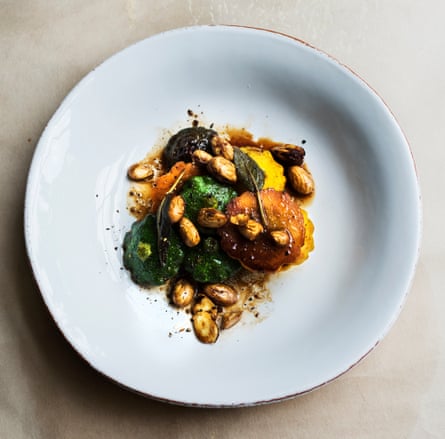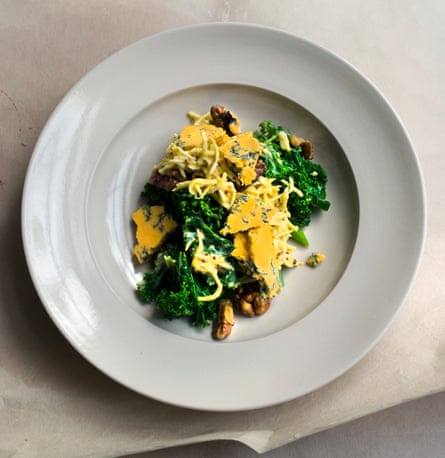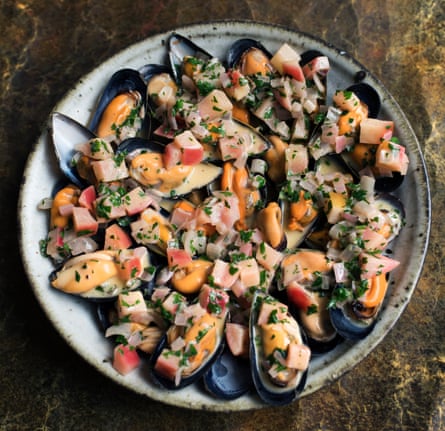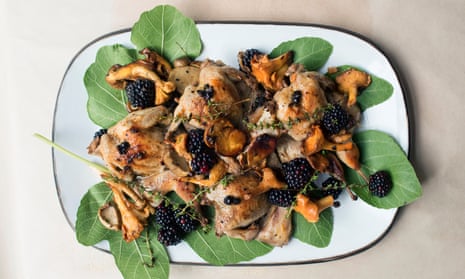Sweet young mussels, crisp new season’s nuts, wild mushrooms, early apples and late berries – could there be a better time of the year to shop for food? This month’s recipes make the most of the early nuts – the fat cobnuts and sweet walnuts – and the last of the green-fleshed summer squashes. Wild mushrooms are cooked with sweet-flesh young birds and there are berries to use too – the late blackberries and autumn raspberries for adding to roast and sautéed meat and tucking into little homemade pies and tarts. The best ingredients of the season, splendidly yet simply, on a plate.
Quail with wild mushrooms and blackberries
Spatchcocking simply involves splitting each bird along its backbone with a heavy knife or strong kitchen scissors and opening it out flat. It allows the bird to cook quickly and evenly. Use wild mushrooms if you have access to them, or cultivated, such as the small chestnut variety.
Serves 2
quail 4, oven ready
olive oil 50ml
lemon juice 50ml
thyme 10 small sprigs
juniper berries 10
assorted wild mushrooms 275g
blackberries 150g
Using a heavy cook’s knife or kitchen scissors, cut each of the quail through the backbone and open out flat, like a book. In a large bowl, mix together the olive oil, lemon juice, thyme sprigs and juniper berries. Put the quail into the marinade and set aside for an hour or two. Turn the quail occasionally.
Warm half of the marinade in a sauté pan over a moderate heat, add the birds and brown them as evenly as possible, turning as necessary. Add the remaining marinade and the mushrooms to the pan, then, when the mushrooms are lightly coloured, lower the heat and let the quail cook until they are done to your liking. (Pierce the flesh at its thickest part with a skewer to check its progress.)
Add the blackberries and cook for a minute or two till their juices start to run, then serve the quail with the mushrooms, blackberries and pan juices.
Patty pan with cobnuts

A really useful recipe is one which doesn’t tie you to specific ingredients, allowing you to substitute at will. This idea of cooking slices of squash in butter with a little vermouth and herbs can be tweaked according to whatever variety you have to hand, be it courgette, pumpkin, butternut or, as here, cute little patty pans. I suggest cobnuts here, but the new season’s hazelnuts would be good, too.
Serves 2 as a side dish
patty pan 400g, or other small squash
butter 35g
white vermouth 80ml
sage leaves 4
shell-on cobnuts a handful, or hazelnuts
If any of the patty pan squash are larger than a golf ball, cut them in half horizontally. Melt the butter in a shallow pan, add the vermouth then the patty pans. Drop in the sage leaves and sprinkle on a little salt. Cover with a lid, letting the squashes simmer in the wine and butter for about 20 minutes until tender to the point of a knife. Keep the heat fairly low, basting the vegetables regularly with the pan juices.
While the squashes cook, crack the cobnuts or hazelnuts and remove them from their shells. Add the nuts to the pan, grind over a little black pepper then serve, spooning over the buttery juices as you go.
Broccoli, blue cheese and walnuts with horseradish

The new season’s walnuts are pale in colour and have a light, almost milky character. They are just the job for adding to a salad of blue cheese and greens such as this.
Serves 2
thin-stemmed broccoli 250g
kale 50g, inner heart leaves
celeriac 125g, peeled
lemon ½
shelled walnuts 40g
walnut or groundnut oil 1 tbsp
firm blue cheese 300g
For the dressing
egg yolk 1
dijon mustard 2 tsp
grain mustard 1 tbsp
fresh horseradish 10g, grated
olive oil 60ml
lemon juice 2 tspl
Cook the broccoli in deep boiling water for 3 minutes until the colour is bright and the stem is tender but crisp. Immediately remove from the water, drain and lower into a bowl of iced water. Add the kale leaves to the boiling water, leave for a minute then drain and add to the bowl of cold water. Coarsely grate the celeriac, then put it into a bowl and squeeze over the juice of the halved lemon.
In a shallow pan, toast the walnuts in the walnut or groundnut oil till browned and fragrant. Drain and set aside.
For the dressing, put the egg yolk in deep mixing bowl, then add the mustards. Stir in the horseradish then introduce the olive oil a little at a time, beating continuously with a balloon whisk until the dressing has thickened. It should be thick enough to lightly coat the vegetables. Whisk in the lemon juice.
Drain the broccoli and slice each piece in halve lengthways. Drain the kale. Toss the celeriac and dressing together. To serve, pile the broccoli on a serving plate, spoon over the kale, grated celeriac and toasted walnuts, then crumble over the blue cheese.
Mussels, apples and cider

We had the first, small, sweet mussels of the autumn the other night, their top shells removed, the chubby little chaps sitting in a cream and cider sauce. I know a kilo sounds a lot of mussels for two, but it is surprising how many you can get through. Bread, something crisp-crusted and chewy, is virtually a necessity here.
Serves 2-3
shallots 2 medium-sized
sweet apples 2 small
mussels 1kg
butter 40g
medium-dry cider 350ml
double cream 150ml
parsley a handful, chopped
Peel and finely chop the shallots. Core the apples and cut them into 1cm cubes, leaving the skin on. Scrub the mussels, checking them for any that don’t close when tapped firmly on the side of the sink or are chipped or cracked.
Melt the butter in shallow pan, add the shallots and cook over a moderate heat until they are translucent. Add the apples and let them cook till they soften. They should retain their shape. Pour in 200ml of the cider, let it come to the boil then add the cream and let the sauce bubble at a sprightly pace until it is reduced by half. Stir in the parsley and season with salt and pepper.
In a large, deep pan, heat the remaining 150ml of cider, then add the cleaned mussels. Cover tightly with a lid and let them steam for 2 or 3 minutes until their shells have opened. Remove the mussels from their cooking liquid with a draining spoon, snap off the top, empty shell from each mussel. Place the lower shells with their cargo of mussels in warm bowls or deep plates, make sure the apple sauce is hot then spoon over the mussels and serve.
Raspberry apple pastries

Puff pastry, the new season’s apples, hazelnuts and late raspberries. The essence of early autumn. The simplest imaginable dessert, made in minutes, for eating warm from the oven with creme fraiche.
Makes 4 tarts
dessert apples 425g
caster sugar 3 tbsp, plus 4 tsp
water 75ml
raspberries 150g
puff pastry 250g
egg 1, beaten
hazelnuts 30g
cream or creme fraiche to serve
You will need two baking sheets, one lined with baking parchment. Place the empty baking sheet in the oven to get hot, setting the oven at 200C/gas mark 6. Peel and core the apples, then cut them into quarters. Put them in a medium-sized, heavy-based pan with three tablespoons of the sugar and the water. Cover with a lid, and simmer for 10 minutes until soft enough to crush. Remove from the heat, then mash to a rough, firm puree with a fork. Fold in the raspberries, crushing lightly as you go.
Roll the pastry into a rectangle measuring 38cm x 30cm. Using a pastry cutter or a small saucer, cut 8 x 12cm circles. (This may require re-rolling the pastry cuttings for the last one or two.) Place four of the discs of pastry on the parchment-lined baking sheet. Divide the apple and raspberry filling between them piling it gently into the centre of each.
Brush the rim of each of the four filled pastry discs with the egg wash, lower a piece of the reserved pastry onto each pressing down firmly around the edges to seal. Roughly chop the hazelnuts. Brush the top of each tart with the beaten egg, then scatter the hazelnuts over the top. Dust with the caster sugar, pierce a small hole in the top of each, then bake for 20 minutes still golden and nicely risen. Serve with the cream or creme fraiche.
Email Nigel at nigel.slater@observer.co.uk or follow him on Twitter @NigelSlater
